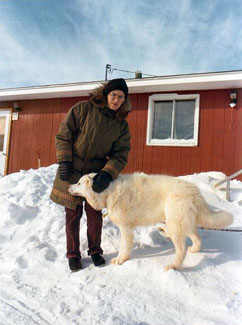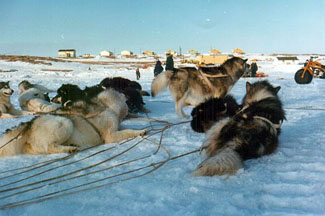From the Editor
Recollections: Life on the Land
Sled Dogs of Russia
An Examination of Traditional Knowledge:
The Case of the Inuit Sled Dog, Part 2
In the News
For the Love of a Retired Sled Dog
The Chinook Project to Visit Labrador
Behavior Notebook: Some Aspects of Dog Behavior
Behavior Notebook: More on Boss Dogs
About Previous Articles in The Fan Hitch
IMHO: Timelessness
Navigating This Site
Index of articles by subject
Index of back issues by volume number
Search The Fan Hitch
Articles to download and print
Ordering Ken MacRury's Thesis
Our comprehensive list of resources
Talk to The Fan Hitch
The Fan Hitch home page
ISDI home page
Editor-in-Chief: Sue Hamilton
Webmaster: Mark Hamilton
Print Edition: Imaged and distributed by the IPL students of the Ulluriaq School, Kangiqsualujjuaq, Nunavik
The Fan Hitch,
Journal of the Inuit Sled Dog International,
is published four times a year. It is
available at no cost online at:
https://thefanhitch.org.
Print subscriptions: in Canada $20.00, in USA $23.00, elsewhere $32.00 per year, postage included. All prices are in Canadian dollars. Make checks payable in Canadian dollars only to "Mark Brazeau", and send to Mark Brazeau, Box 151 Kangiqsualujjuaq QC J0M 1N0 Canada. (Back issues are also available. Contact Sue Hamilton.)
The Fan Hitch welcomes your letters, stories, comments and suggestions. The editorial staff reserves the right to edit submissions used for publication.
Contents of The Fan Hitch are protected by international copyright laws. No photo, drawing or text may be reproduced in any form without written consent. Webmasters please note: written consent is necessary before linking this site to yours! Please forward requests to Sue Hamilton, 55 Town Line Rd., Harwinton, Connecticut 06791, USA or mail@thefanhitch.org
Print subscriptions: in Canada $20.00, in USA $23.00, elsewhere $32.00 per year, postage included. All prices are in Canadian dollars. Make checks payable in Canadian dollars only to "Mark Brazeau", and send to Mark Brazeau, Box 151 Kangiqsualujjuaq QC J0M 1N0 Canada. (Back issues are also available. Contact Sue Hamilton.)
The Fan Hitch welcomes your letters, stories, comments and suggestions. The editorial staff reserves the right to edit submissions used for publication.
Contents of The Fan Hitch are protected by international copyright laws. No photo, drawing or text may be reproduced in any form without written consent. Webmasters please note: written consent is necessary before linking this site to yours! Please forward requests to Sue Hamilton, 55 Town Line Rd., Harwinton, Connecticut 06791, USA or mail@thefanhitch.org
The Inuit Sled Dog International
The Inuit Sled Dog International (ISDI) is a consortium of enthusiasts whose goal is the preservation of this ancient arctic breed in its purest form as a working dog. The ISDI's efforts are concentrated on restoring the pure Inuit Dog to its native habitat. The ISDI's coordinators welcome to your comments and questions.
ISDI Coordinator Canada:
Genevičve Montcombroux, Box 206, Inwood, MB R0C 1P0; gmontcombroux@gmail.com
ISDI Coordinator USA:
Sue Hamilton, 55 Town Line Road, Harwinton, CT 06791, mail@thefanhitch.org

Marie Irniq and Nakataq, c. 1980s
photo:Irniq
Life on the Land:
Recollections of Peter Irniq
Since time immemorial, our dogs have always been our companions and workhorses. Whenever we traveled on the land in the winter, they pulled our heavy qamutiit, normally loaded with all our gear, including our country meat. In the summer, when we would walk inland to hunt caribou, they would help carry all our belongings, including our tents, caribou meat, and whatever else we needed. In the winter, when we were out seal hunting when the seal holes were covered with snow, we trained them as tasikuat (professional dog smellers) to sniff out the seal holes, way down below the snow bank. Our dogs had the ability to find their way home even during the worst blizzard conditions when we, the masters, were no longer able to find our way.
It was always up to the lead dog, known as isurartujuq, to lead the way.
The animals were company for our families, were loyal friends, protected us by giving warnings of approaching danger such as polar bears, and kept us warm when we needed it. Their fur made good durable mitts and fur around our hoods.
Dogs were also our lifelines. Some days we used them to communicate for us. We would write a short note in Inuktitut syllabics, tie it with a piece of string around their necks, and send them to another camp, carrying the message.
Our dogs were highly respected for their knowledge and wisdom; Qimmit was sometimes used as a proper name of a person. Such a name was Qimmittiaq (beautiful dog,) a person from Kuugaarruk (Kugaaruk).
To have a full team, the owner would have between five and ten dogs, using both male and female dogs to pull the sleds. A mother, who was part of the team, had a mamautailitaq (dog bra), normally made out of caribou skin, which was used to keep the mamautit (dog breasts) from freezing at -40 or -50C. When traveling, the puppies would be inside a box and carried on the sled.

Nujaat (Repulse Bay) May 1979 photo: Irniq
We were always taught to respect our dogs. In the spring, when the sea ice became dry from the spring thaw and there were icicles, my father or my brother-in-law, used to make kamiik (booties) for the dogs, so the bottoms of their feet didn’t get cut. My father used to say, "If you look after your dogs well, they will always listen to you."
Here are examples of how to direct your dogs, in the Aivilik dialect, when you are traveling: Hai! (Get up and go!); Hut hut (Go fast); Uut uutaa! (There is a seal basking – go faster!); Arik arik (Turn left); Auva’iak uaa… uaa (Turn right, turn right); and Uuaa, uuaa! (Stop).
When I was five-years-old living in Nattiligaarjuk (Committee Bay), a distance of almost 60 miles west of Naujaat (Repulse Bay), we used to fish at saputit (fish weir), when the fish were swimming back up stream. As a five year-old fishing inside the fish dam, I used to get very cold, especially in the evenings. Each one of us used to have our own personal dogs, and my father had his own personal puppy, perhaps about three weeks to a month old. When we would go back in the tent at night and it used to be so cold, my father and I would cuddle up to the little puppy to warm us up. Nakataq was a very treasured little puppy, like all the others. In later years, Nakataq became the boss of our dogs and he was a good boss. I have a great deal of respect for our dogs. It is our dogs that allowed us to be Inuit for thousands of years.
The Inuit Dog made Inuit fiercely independent. True! My mother and my father, along with my sister and my older brother, traveled in the late 1930s from Utkuhiksalik (Back River) through Wager Bay, Repulse Bay, Hall Beach, to Igloolik and then to Baffin Island, all by dog team. Around 1949, they started heading back to Back River but my father said their dogs died off in Repulse Bay and this where they got stuck. My father had the larger dogs then. But when he was given some dogs in Repulse Bay, they were smaller ones but still, they were very good dogs. In fact, my father was often the envy of people in Repulse Bay, as he was an extremely good hunter. I am not even half as good as he was.
Peter Irniq lived most of his life in the Kivalliq Region of what is now known as Nunavut. He has held many offices in government and Inuit organizations including Northwest Territories Legislature, president of the Keewatin Inuit Association, executive director of the Inuit Cultural Institute, director of communications for Nunavut Tunngavik Incorporated, member of the Nunavut Implementation Commission, assistant director Nunavut Heritage/Culture, Department of Education, Culture and Employment for the Government of N.W.T and deputy minister of Culture, Language, Elders and Youth. In August 1999, Irniq was seconded to the Legislative Assembly of the newly formed Nunavut Territory to set up the offices of the Official Languages, Access to Information and Conflict of Interest Commissioners.